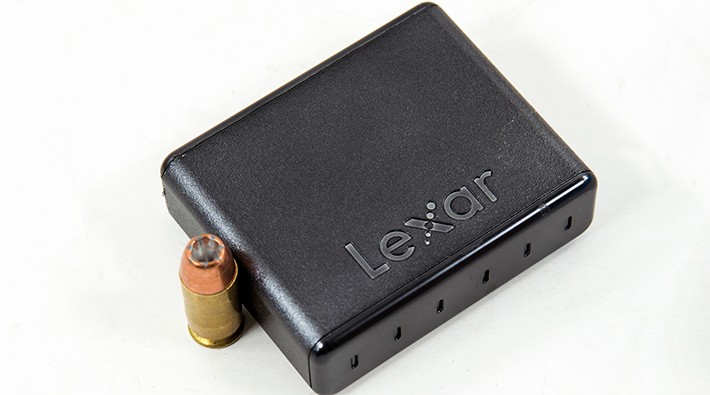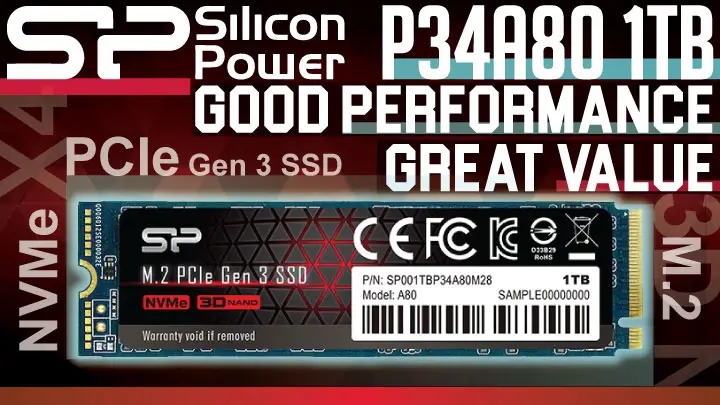Lexar Portable SSD – Closer Look at the Lexar Portable SSD
 While technically not part of the ‘Workflow’ lineup it did come as a surprise to see the shipping container was nothing like any of the previous Workflow card reader’s shipping containers. Instead of a clear plastic container with the top half housing the Portable SSD and the bottom half the accessories, Lexar has instead opted for a white cardboard box. This certainly affords the Portable SSD much more protection while at the same time being fairly attractive and attention getting. Whether you consider it to be superior to the Workflow series aesthetics will come down to personal preference – as both are good. On the truly positive side the back of the box – just as with the Lexar Professional series –lists both the read and write performance specifications. In the Portable SSD this means 450MB read and 245MB write – both of which are rather decent for a relatively large, portable flash drive in this price range.
While technically not part of the ‘Workflow’ lineup it did come as a surprise to see the shipping container was nothing like any of the previous Workflow card reader’s shipping containers. Instead of a clear plastic container with the top half housing the Portable SSD and the bottom half the accessories, Lexar has instead opted for a white cardboard box. This certainly affords the Portable SSD much more protection while at the same time being fairly attractive and attention getting. Whether you consider it to be superior to the Workflow series aesthetics will come down to personal preference – as both are good. On the truly positive side the back of the box – just as with the Lexar Professional series –lists both the read and write performance specifications. In the Portable SSD this means 450MB read and 245MB write – both of which are rather decent for a relatively large, portable flash drive in this price range.
 In either case, internally the box has the same dual chamber configuration as the Workflow series it really should be officially part of. To be specific when you open the box up you will be greeted with the drive sitting in a cardboard separator and the accessories tucked away underneath it. The accessories included are also classic Lexar Workflow series in that they consist of a long USB 3.0 Type-A to Type-B cable, and paper slip with a serial number for Lexar’s Image Rescue 5 software.
In either case, internally the box has the same dual chamber configuration as the Workflow series it really should be officially part of. To be specific when you open the box up you will be greeted with the drive sitting in a cardboard separator and the accessories tucked away underneath it. The accessories included are also classic Lexar Workflow series in that they consist of a long USB 3.0 Type-A to Type-B cable, and paper slip with a serial number for Lexar’s Image Rescue 5 software.
 Unless one takes a long and careful look at this model, anyone could be forgiven for thinking it was one of the various Lexar Workflow readers; however as this is not a card reader but a storage device, it is not technically a Workflow device. Though neither is it part of the Lexar Professional storage series as it is not a removable card meant for a camera or portable device. Instead this model carefully straddles both series and acts as a force-multiplier for both.
Unless one takes a long and careful look at this model, anyone could be forgiven for thinking it was one of the various Lexar Workflow readers; however as this is not a card reader but a storage device, it is not technically a Workflow device. Though neither is it part of the Lexar Professional storage series as it is not a removable card meant for a camera or portable device. Instead this model carefully straddles both series and acts as a force-multiplier for both.
This is why it has the exact same form-factor as the Workflow card reader models and has the same USB 3.0 Type-B port on the back. Really the only telltale hints that it is not a Workflow card reader – besides the ‘missing’ card slot on the front – is the grayer color instead of black, and the additional LEDs on the front. To be specific there are six LEDs on the front. The leftmost one glows when the device is connected and powered up – and acts as a status indicator much like on a router.
 The other five LEDs act as an instant capacity status indicator. When empty none will glow, when the drive is at 20% filled capacity one will glow, when at 40% two will glow, and so on and so forth. This way, with just a quick glance, consumers will be able to tell how much space is left on the Portable SSD. Unfortunately, as they are active and not passive status indicators you will only be able to – roughly – tell how much space is left by first plugging it in. Put another way, when powered off and in your camera bag there is absolutely no way to tell how full the Portable SSD is.
The other five LEDs act as an instant capacity status indicator. When empty none will glow, when the drive is at 20% filled capacity one will glow, when at 40% two will glow, and so on and so forth. This way, with just a quick glance, consumers will be able to tell how much space is left on the Portable SSD. Unfortunately, as they are active and not passive status indicators you will only be able to – roughly – tell how much space is left by first plugging it in. Put another way, when powered off and in your camera bag there is absolutely no way to tell how full the Portable SSD is.
 This issue is not all that big a deal as this device really is not meant to be used as a standalone model. In fact, the designers did not envision using it like a large and chunky ‘thumb drive’, nor like a smaller external hard disk drive storage device. Instead this model was designed to be used in conjunction with Workflow card reader models. Specifically, it is meant to make life easier for professionals by offering a quick place to empty ‘filled’ cards during a photoshoot. However, to truly harness the power of this device consumers need to pair it with the Workflow Hub device. As it weighs more than most we recommend placing it in the bottom most slot and filling the other three with whatever Workflow card-readers are needed. When this is done, only a single USB 3.0 cable is needed and multiple cards can be simultaneously transferred to this external storage solution.
This issue is not all that big a deal as this device really is not meant to be used as a standalone model. In fact, the designers did not envision using it like a large and chunky ‘thumb drive’, nor like a smaller external hard disk drive storage device. Instead this model was designed to be used in conjunction with Workflow card reader models. Specifically, it is meant to make life easier for professionals by offering a quick place to empty ‘filled’ cards during a photoshoot. However, to truly harness the power of this device consumers need to pair it with the Workflow Hub device. As it weighs more than most we recommend placing it in the bottom most slot and filling the other three with whatever Workflow card-readers are needed. When this is done, only a single USB 3.0 cable is needed and multiple cards can be simultaneously transferred to this external storage solution.
While this is the ‘optimal’ use of the Lexar Portable SSD, this is not to say it has to be used in this way. Lexar’s designers did understand that not everyone can justify the price of the HUB HR1/HR2 models and as such many will simply opt to use two USB ports. One for this device and one for their card reader(s). This is why the underside of the Portable SSD has rubber inserts that keep it from needless sliding around on any smooth surface.














